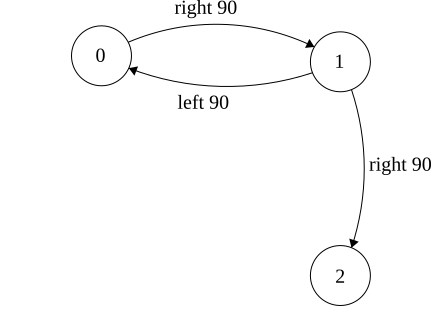CMSC330
Finite Machines
Finite Machines
Finite State Machines
Finite State Machines
Make a graph to model actions and states of the world

Make a graph to model actions and states of the world

Make a graph to model actions and states of the world

Make a graph to model actions and states of the world

Make a graph to model actions and states of the world

Make a graph to model actions and states of the world

Make a graph to model actions and states of the world

Make a graph to model actions and states of the world

Make a graph to model actions and states of the world

Make a graph to model actions and states of the world

- 0: Face North
- 1: Face East
- 2: Face South
- 3: Face West
Based on where I am, and what I see, go elsewhere

Each Node is a State, and they are finite
Each Node is a State, and they are finite
Basis for Push Down Automata and Turing Machines
Limited operations, but enough for Regex
Regex
Recall the things we needed for Regex
- Alphabet
- Concatenation
- Branching
- Repetition
Recall the things we needed for Regex
- Alphabet
- Set of symbols allowed
- Denoted by: \(\sum\)
- String: finite sequence of symbols from \(\sum\)
Recall that a Regex describes a set of strings
This set is called the language
Recall the things we needed for Regex
- Concatenation
- Suppose that \(L_1\) and \(L_2\) are languages
- \(L_1\) concatenated with \(L_2\): \(L_1L_2\)
- \(L_1L_2 = \{xy \vert x \in L_1 \land y \in L_2\}\)
\(L_1 = \{'c'\}, L_2 = \{'m'\}, L_{3} = \{'s'\}\)
\(L_1L_2L_3L_1\) = /cmsc/
Recall the things we needed for Regex
- Branching (Union)
- Suppose that \(L_1\) and \(L_2\) are languages
- \(L_1\) unioned with \(L_2\): \(L_1 \cup L_2\)
- \(L_1 \cup L_2 = \{x \vert x \in L_1 \lor x \in L_2\}\)
\(L_1 = \{'a'\}, L_2 = \{'b'\}, \dots, L_{26} = \{'z'\}\)
\(L_1\cup L_2\cup \dots \cup L_{26}\) = /[a-z]/
\(L_1 = \{'a'\}, L_2 = \{'b'\}, \dots, L_{26} = \{'z'\}\)
\(L_1\cup L_2\cup \dots \cup L_{26}\) = /[a-z]/
\(L_{27} = \{'0'\}, L_{28} = \{'1'\}, \dots, L_{37} = \{'9'\}\)
\((L_1\cup \dots \cup L_{26})(L_{27}\cup \dots \cup L_{37})\) = /[a-z][0-9]/
\(((L_1\cup \dots \cup L_{3})(L_1\cup \dots \cup L_{3}))\cup (L_1\cup \dots \cup L_{3})\) = /[abc]{1,2}/
\(L_{38} = \{'-'\}\)
\((L_{38}(L_{27}\cup \dots \cup L_{37}))\cup (L_{27}\cup \dots \cup L_{37})\) = /-?\d/
\((L_1\cup \dots \cup L_{n})\) = /./
Recall the things we needed for Regex
- Repetition (Kleene closure)
- Suppose that \(L_1\) is a language
- The Kleene Closure of \(L_1\): \(L_1^*\)
- \(L_1^* = \{x|x \in \epsilon \lor x \in L_1 \lor x \in L_1L_1 \lor \dots\}\)
\(L_1 = \{'a'\}\)
\(L_1^*\) = /a*/
\(L_1L_1^*\) = /a+/
We can put everything together to make a grammer
\(\begin{array}{rl} R \rightarrow & \emptyset\\ & \vert \epsilon\\ & \vert \sigma \\ & \vert R_1R_2\\ & \vert R_1\vert R_2\\ & \vert R_1^*\\ \end{array} \)
More on Grammars later
More on Grammars later
Languages created by Regular Languages are regular languages
Suppose \(L\) is a language created by a RE \(r\)
If string \(s \in L\) then \(r\) accepts \(s\)
Not everything can described with Regex
Regex and FSMs
Goal: create a machine to see if \(r\) accepts \(s\)
This machine can be represented by a FSM


Let's break this down
- Two States: S0, S1
- Initial State: S0
- Accepting State: S1
- Transistions: 0,1

Let's break this down
- Two States: S0, S1
- Initial State: S0
- Can only have 1
- Accepting State: S1
- Transistions: 0,1

Let's break this down
- Two States: S0, S1
- Initial State: S0
- Accepting State: S1
- Can only have zero or more
- Transistions: 0,1

Let's break this down
- Two States: S0, S1
- Initial State: S0
- Accepting State: S1
- Transistions: 0,1
- Denote symbols on an Alphabet
What is this Regex?

even binary numbers or the empty string
What is this Regex?

/((a*b+)|(a+b*))c+/
What is this Regex?

month/day/year Date format
What would this machine look like?
Strings with even number of 0s and odd number of 1s

What would this machine look like?
strings of a, b, and c with no same consucutive letters
